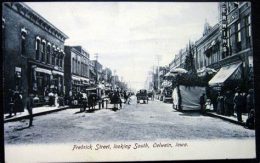Drugs and Deindustrialization:
Nick Reding’s Methland
Morris van de Camp
Methamphetamine is the drug for people in hardworking cultures. It was first synthesized in Japan in 1893. It was used by the German and American armies during the Second World War. Initially, meth was considered a miracle drug. It was a pick-me-up that also treated depression, obesity, and erectile dysfunction. Meth also helped a person work hard without breaks, food, or water.
As with all miracle drugs, there is a price. To put it simply, meth (also called crystal, crank, ice, or speed) wrecks the user’s health and puts the user out of his mind. Addicts leave behind a trail of destruction; while on meth, they commit different crimes and might sexually abuse their own children as meth makes the libido uncontrolled. Meth use in the gay community is also correlated with increased infections of AIDS and Hepatitis C.
The impact of meth on a small town in Iowa is documented by Nick Reding in his book Methland: The Death and Life of an American Small Town. Although he mentions in the book a number of small towns in the Midwest, Reding focuses on Oelwein, Iowa, a town situated approximately 260 miles west-northwest of Chicago.
Although Methland was published in 2009 and its research was done during the dreadful “Peak Bush” years of 2006, the socioeconomic conditions remain in place for the dystopia described by Reding. The white working class remains in economic and moral peril. For every addict, there are damaged children and families, and fewer of our own people able to advance the collective interests of our race. Those who spend their time high fail to advance their career and generate prosperity. Drug use is an agent of white dispossession.
Initially, meth use wasn’t much of an epidemic. However, the social revolutions of the 1960s provided an opening, or perhaps created a larger opening, for a culture of widespread drug abuse. (One might speculate that whites took to drugs after their elite was displaced by a Jewish elite at that time.) Meth was outlawed in 1970.
The meth situation was extant, although manageable, in Iowa until the Farm Crisis of the 1980s. In the wreckage-strewn wake of the Crisis, matters were made even worse by the neoliberal trade policies of the Bush Senior and Clinton administrations which further damaged the economy of Iowa. Wages fell when Oelwein’s meatpacking plant was sold to a globalist firm. Small farms disappeared into the property of companies like Archer Daniels Midland, or absorbed into the farms of locals that made it through the 1980s. When the meatpacking plant finally closed for good, Oelwein’s economy collapsed, with social disorder following. Streetlights weren’t lit at night, there were fewer police, the jail was not funded, and abandoned houses were prime targets to become meth labs. Idle hands became the devil’s playthings.
This economic desperation occurred when many Iowans and other Midwesterners had settled in Southern California. Los Angeles, writes Reding, was America’s ground zero for meth. Local Mexicans had figured out how to manufacture the drug, and LA’s Iowan population became involved in smuggling meth for users back home. By the mid-1990s, it was widely known how to cook meth and illicit labs popped up across the inland United States. At the same time, the illegal Mexicans who poured into the United States following the North American Free Trade Agreement and the deliberate collapse of border enforcement provided a massive network of transporters and dealers. Non-white immigrants were clearly a major factor in the spread of the drug.
Turning Things Around
In 2006, the mayor of Oelwein rolled the dice and turned things around. His first act was to replace the chief of police with a long-serving sergeant. This move turned out to be a bold masterstroke of hiring to match political goals. Oelwein’s police department had been slack and corrupt. The police sergeant’s backstory also matches what I’ve found about organizations with dishonest leadership; there are often fast and loose accusations by the most corrupt person leveled at those more honest or effective. The sergeant had been accused by the chief of being a peeping tom, among other perversions, all while the police chief was turning a blind eye to the meth crisis. The sergeant had to skip over the chain of command to talk directly to the mayor in a private office call and plead his case.
After enacting tougher law enforcement, the mayor convinced the town to vote a tax upon themselves to turn abandoned space into a new industrial park and revamp the sewer system. The risk paid off, the industrial park ended up being used by a community college. Meanwhile, abandoned houses were condemned so as to remove potential spots for a meth lab.
Things to think about
Books like Methland are important for white advocates to read and understand because there are a great many towns like Oelwein, Iowa out there. These towns are part of the broodlands of our people. Indeed, Madison Grant wrote:
Iowa, being predominantly agricultural, has felt particularly the unfavorable status of agriculture since the World War. During the decade 1920-30, three of every five of the villages in the State actually lost in population, the people having either moved into the cities or “gone West.” Here as elsewhere, the small village seems unable to meet the needs of the inhabitants. One of the real problems of statesmanship in the near future is to work out a social and economic system under which a larger part of the old native stock, and particularly the most intelligent portion of it, can live under the favorable biological conditions of the small village. [1]
Drug use and addiction must be faced head on. Carry A. Nation was not entirely wrong in denouncing alcohol, and Nancy Reagan was absolutely right to push kids to “just say no.” In some cases, it is okay to have a pint or smoke a joint — but these actions can easily spin out of moderated control. I encourage all white advocates to take a look at their use of intoxicating substances and see if they need to change their behavior.
When meth was a legal drug, it was not as potent as the current, illegal form commonly used today. This situation is part of a trend; consumer choice is making all intoxicating substances more powerful. In Appalachia, where opium is the king drug, a dealer who had a client overdose gets more customers as he is presumed to be peddling more potent stuff. The amount of THC present in marijuana was 2 percent on average in 1970. It is 25 percent today. Wine has gone from 9 percent alcohol to 12 percent, and it is still sold in large quantities. Wine glasses in restaurants are larger than before.

Rust Belt USA [2]

Europe, especially England, has a Rust Belt too. [3]
Notes
[1] Grant, Madison, The Conquest of a Continent (New York: Charles Scribner’s Sons, 1933), 252.
[2] Lyman Stone, “Where Is The Rust Belt?” Medium, 1 March 2018. [http://archive.is/0kOwV] [https://medium.com/migration-issues/where-is-the-rust-belt-d1dd280cf8a8]
[3] Jordan-Bychkov, Domosh, Neumann, & Price, The Human Mosaic: A Thematic Introduction to Cultural Geography, 10th ed. (New York: WHFreeman, 2006), Fig. 9-4.
Drugs%20and%20Deindustrialization%3A%20Nick%20Redingand%238217%3Bs%20Methland
Enjoyed this article?
Be the first to leave a tip in the jar!
Related
-
Stalin’s Affirmative Action Policy
-
Doxed: The Political Lynching of a Southern Cop
-
James M. McPherson’s Battle Cry of Freedom, Part 2
-
James M. McPherson’s Battle Cry of Freedom, Part 1
-
National Socialism as a Magical Movement: Stephen E. Flowers’ The Occult in National Socialism
-
Communist Barbarism in Hungary — and America Today: When Israel Is King
-
Introducing a Reactionary Aphorist
-
The Establishment’s Radicals




18 comments
Excellent and important article. If I may, I must somewhat dispute this:
‘Wine has gone from 9 percent alcohol to 12 percent, and it is still sold in large quantities. Wine glasses in restaurants are larger than before.”
The latter may be true, but I would dispute the inference that therefore more wine is being consumed. Last Friday, during the Happy Hour at a local bar, I was served what Kingsley Amis would have called “the smallest drink I’ve ever been seriously offered.”
Of course, the martini I had previously consumed was of what I would consider a normal size, at least by traditional standards; which leads leads me to point out that what has changed elsewhere is the size, and portions, of hard liquor. If you look at an old film like North by Northwest, you can see Cary Grant being served drinks in glasses so small they disappear behind his hand. The infamous “three martini lunch” Carter attacked was possible only with those portions. With the subsequent “Bachelor Pad” fad, bars and restaurants began serving newcomers ridiculous portions in large glasses, with corresponding prices.
Here in Stars Hollow, the old ways of drinking may survive today. One thing however has changed ever here: the “craft beer” and “gastropub” fad. Arguably a White activity (from time to time articles appear bemoaning #craftbeersowhite). Judging from the menus, the alcohol content seems to range from a reasonable 4.5% all the way up to almost 15%!
It’s notable that the Dissident Right sneers at the “wine aunts” but “manly” drinks like beer and gin/vodka seem to be where the real over-consumption is being promoted.
Those are shot glasses you are talking about seeing Cary Grant drink. Probably ditto the small drink you were served. Taller, but thicker glass and the same amount as the common size shot glass. Martinis, Manhattan’s, and mixed drinks have never been served in that small a portion.
Not wanting to start a bar fight, but… there’s quite a difference btw a shot glass and a martini glass! Apart from having a stem (so as not to warm the drink) they come in various sizes, from 5oz to 10, with the latter obvious twice the size as the former. (http://bestreviews.com/best-martini-glasses).
“Small glasses aren’t just practical for classic recipes, they’re also stylistically appropriate. Over the years, cocktail glasses have grown supersized, ballooning from the modest 3- to 4-ouncers that were standard in 1930s to the imposing 8- to 10-ouncers so ubiquitous today. But if you’re fixing yourself an old-timey classic such as a Martini or a Manhattan, a Jack Rose or a Sazerac, why not choose a glass befitting William Powell in The Thin Man (1934), or Bette Davis in All About Eve (1950)? Go small.”
https://www.thekitchn.com/3-reasons-you-should-choose-sm-137356
And “supersized” is right; my point being that the markup on alcohol, like french fries, is so high that bars can effectively double portions and still make a mint from customers who think they’re “getting more for the money.” The effect on patrons, in either case, be damned.
A more civilized White world: Cary Grant with 3 maybe 4oz glass; compare portion to hand:
https://cinemiam.files.wordpress.com/2013/01/nbn-gibson-gp.jpg?w=1024&h=576
Ok.
What we typically hear is that reindustrialization is pointless because the “workers” will be mostly robots.
“In some cases, it is okay to have a pint or smoke a joint — but these actions can easily spin out of moderated control” – No, in my opinion it’s not okay to drink a “pint” or smoke a joint. Sure, it’s legal but if you’re drinking a “pint” of beer or hard liquor, you’ve likely got some deeper issues going on. Most people don’t begin their alcohol career with a “pint,” but with a glass, or two, or three – and yes, “these actions can easily spin out of moderated control.” This is because humans are easily addicted to what feels good. One or two of a good thing quickly turns into continuously more and more of a good thing – until we care completely consumed by the substance itself.
Like most vices that enslave us, it’s incremental over time and not immediately discernible to the user. The problem is that most people can’t moderate it, at least from my experience as a street cop (now retired) for years who worked among both the rich and the poor. Yes, many can but I seriously doubt it’s most people due to the enormous pressure to drink and the widespread commercialization of it. Alcohol is part-and-parcel to anything to social, and thus is always present beckoning us to partake.
The wake of personal destruction, loss of wealth and employment, not to mention the families that alcohol has decimated is incalculable. In almost every family dispute, domestic violence, and public fights I responded to as a cop, alcohol was almost always a major factor.
Alcohol, in my opinion, has proven to be a curse to the white man, and has limited our real potential and accomplishments. I don’t have any statistics to prove this, but I find it hard not to believe that we as a race could have accomplished so much more had not alcohol, marijuana, and illicit drugs played such a powerful role in our collective lives.
As for marijuana, today’s ‘reefer’ is much stronger than that of the 1960s and 1970s, and has greater negative effects too. Granted, it may not be as insane as Meth, but it comes with its own set of problems. It too can be very addictive, tends to decrease motivation and personal drive, shown to have negative effects on young people with a growing brain, and dulls the senses and makes one over time apathetic over life (except getting high, of course). Apathy, I believe, is the very thing our government wants among the national population, and it doesn’t surprise that marijuana legalization is pursued so strongly by the entire Globohomo matrix.
Sure, their are some people who can behave responsibly and maintain some order in their lives as marijuana users. However, I tend to think these people are the exception, and not the norm. It’s only when people get out of the marijuana ‘lifestyle’ that they finally admit to themselves its ruinous power.
As for the legalization of ALL drugs that some are promoting, European whites who seriously consider their racial and cultural(s) survival ought to think about the long-term effects this will have on future generations of their people. What kinds of new diseases, mental disorders, new deformities, auto-immune issues, and new types of Autism will we have to deal with when anything and everything is allowed to be ingested and smoked? What kind of people will this turn us into? What will we have to offer future generations of whites if our lives are stuck in a drunken stupor, or we are too dull-minded and unconcerned because marijuana has made us totally apathetic about our own racial survival?
Those whites who propagandize for the legalization of all drugs fail to seriously the long-term effects it will have on our people. The very notion springs from the Jewish mindset of destroying the Goyim, rather than from the mindset of what is best for the heath and survival of the white race.
In short, this is not time in history to be inebriated, to have our senses and mental sharpness dulled. We need now to be especially alert and ‘watching our six.’ A doped up nation is a defeated nation.
When I see Alt-Right guys drinking heavily and ‘partying,’ it immediately tells me that they’re not serious about their cause (at least not in the way I think they should be). All sorts of errors, poor judgment, and indiscretions occur when alcohol and marijuana become an important part of our lives.
As racially-conscious white, we need to think much differently about alcohol and marijuana.
Well said. I used to be a shallow libertarian re drugs, but as I have come to reject radical individualism (I still embrace a moderate, traditional American variety rooted in “householder” independence opposed to socialist collectivism), I think society has every right to defend itself as an entity which is communal, self-replicating, and abiding. Part of that defense is indeed avoidance of genomic pollution, which means vigilance against drugs (and improper alcohol consumption, though the latter is ancient and part of our race’s history, and thus far less objectionable than alien ‘weed’, let alone synthetic narcotics).
Agree with you and also with Kane on most points except the last. Drug use should be avoided, but cannabis isn’t something alien to our race at all, in fact it’s the Aryan psychedelic substance par excellence as shown for example by the widespread yet controlled and productive use among the Scyths.
Consumption of psychoactive substances in general should be tied to initiatory rites and clearly defined challenges. Strictly forbiddden for adolescents and untested ones, but after military service, a certain professional achievement and fathering children a man has earned the right to smoke and drink whatever he wants within the confines of his own home.
Thanks for the comments and I’m glad that in most of this we are in agreement. There is much more that unites us than divides us. However, a few words in response are in order: Marijuana may indeed have been the “Aryan psychedelic substance par excellence” at one time (I really don’t know either way), but its use today among our people seems to have much greater negative effects than it once did thousands of years ago, and more than what was even smoked during the 1960s and 1970s when it was significantly less potent.
In fact, I’m not particularly persuaded that it was even wholly beneficial to the Scyths, nor that it was “controlled and productive,” especially when one considers the innate human proclivity to abuse most things that give pleasure. I could be wrong about this, so I am open to any input you might provide. Either way, I have no reason to believe that marijuana as used by our people throughout the 20th and 21st centuries has made us better and more productive. It seems to me that marijuana has only exacerbated our problems (although I am not against those with legitimate medicinal reasons for using it, particularly if other forms of drugs are not as effective).
While it’s true that “psychoactive substances” should be “strictly forbidden for adolescents,” the problem is that in today’s deviant society of Weimar America young teenagers and young adults are the primary consumers of it. It’s readily available to anyone who wants it, and current drugs laws in Europe and the U.S. are weak and not as diligently enforced as previously. Any and all attempts to make marijuana users responsible and kept out of the hands of kids has failed miserably. Future generations will likely condemn us because of our unwillingness to deal harshly with the continuous and rampant drug epidemic we’ve experienced for the past 50 years.
“a man has earned the right to smoke and drink whatever he wants within the confines of his own home” – This is true, and I am no advocate of the government arbitrarily intruding inside the homes of its citizens to find out what they are drinking or smoking. Hopefully, the kind of man you described in your comments, though honorable, would also have the sense to eschew the very substances that have helped to destroy this once great nation (among other vices)?
This is because humans are easily addicted to what feels good. One or two of a good thing quickly turns into continuously more and more of a good thing – until we care completely consumed by the substance itself.
We need to be very careful never to do anything enjoyable. It’s a slopery slip.
We can do all sorts of things that are enjoyable, and illicit narcotics are not the only substances that can be abused. One can abuse anything, including food, sex, etc. However, when it comes to powerful narcotics, its abuses can be especially devastating for individuals, families and entire nations as we have witnessed for multiple generations.
You may mock my comments as succumbing to a “slippery slope” argument, but has not our history over the past 50 years shown that Americans are anything but moderate and responsible when it comes to their alcohol, marijuana, methamphetamine, and various opioids usage? Has not the widespread acceptance of all sorts of drugs in our society further led us down the path of personal and national ruin? Who can reasonably deny it when one looks at the evidence? Has the so-called ‘freedom’ to practically ingest anything improved our people? You know the answers to such questions.
Isolating my words from the remainder of the comments and case that I made in a dismissive manner is no refutation.
Totally unrelated to the article in question
Is there a place on this website we can submit good links?
I feel like this is good incremental progress happening in the mainstream.
https://www.youtube.com/watch?v=_jhQsp4Ow0A
Amusing photo at the top (Methadrine: a genuinely brighter outlook). It is genuine alright. Genuinely psychotic. It is the sleeplessness that causes the psychosis, and seems weirdly similar to schizophrenia (after the 3rd or 4th day), which made me wonder back then if there was a clue in there for the cause of schizophrenia? If a person doesn’t sleep they go crazy. Is there some processing of a chemical in sleep that schizophrenics can’t do naturally? Staying up for days is interesting, if you have ever experimented with it, because what happens is one starts dreaming while one is awake. It is a state of mind that can easily be more intense than say LSD.
Sorry, but I can’t bring myself to care too much about the fate of whites who are actually quite anti-white in their thinking or are terrible race-mixers. Whites in the Midwest are proud of their anti-racism and relatively high interracial marriage rates.
I’d only blow my extra money on white-positive white people. I say we only focus on saving those who *want* to be saved. We’ve got to call it like it is: we are not one people with random whites in the USA. It would be more useful to create some sort of subculture for ourselves, and dedicate ourselves to its well-being.
do you have any evidence of your slights to midwesterners or is this just some cringy occidental dissent type of wishful thinking from live action role players south of the mason dixon line?
I don’t think re-industrialisation is the answer; just look at Russia. There’s plenty of meaningful work yet the people buy booze and krokodil. Ditto the Step Cult; the rate of recidivism is very high. The really best advice one can give a young person is what President Trump’s brother, Fred, gave him, “If you don’t start, you won’t have to stop.”
“This economic desperation occurred when many Iowans and other Midwesterners had settled in Southern California. Los Angeles, writes Reding, was America’s ground zero for meth. Local Mexicans had figured out how to manufacture the drug, and LA’s Iowan population became involved in smuggling meth for users back home.”
Sometimes I have doubts whether the White Man deserves to be saved from savagery.
Stimulants = right-wing drugs
Depressants = left-wing drugs
The meth epidemic is more a pressing issue for us because /our guys/ are more likely to have a Protestant work ethic and get into meth than oxycotin (oxycodine) or other opiods.
We don’t want people who’re potentially sympathetic to our message killing themselves with drugs, getting arrested, going to prison, etc
At one point, I had an unhealthy habit of ephedra usage. Luckily I was able to exercise self-control and before I moved onto harder things.
Comments are closed.
If you have Paywall access,
simply login first to see your comment auto-approved.
Note on comments privacy & moderation
Your email is never published nor shared.
Comments are moderated. If you don't see your comment, please be patient. If approved, it will appear here soon. Do not post your comment a second time.
Paywall Access
Lost your password?Edit your comment